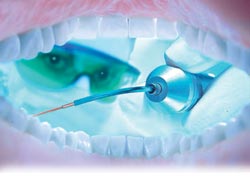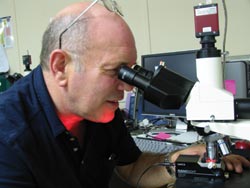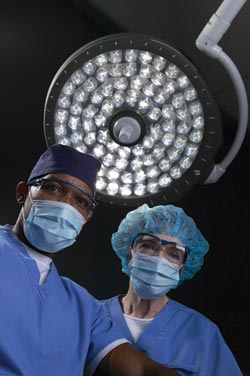Biotech and medical industries are huge energy consumers, so when it comes to upgrading equipment, energy efficiency is a key issue. Technological advances in the latest generation of products have led to energy conservation and reduced use of consumables. When implemented throughout a surgical suite or medical lab, improvements in solid-state lasers, digital imaging and microscopy systems, near-infrared lab instruments, and surgical and hospital lighting can add up to real savings.
Solid-state lasers
Thirty years ago, the trend in lasers was argon-ion gas. These lasers were power-hungry, consuming as much as 10 kW of energy to produce UV light and requiring a waiting period at start-up for the temperature to stabilize; then they required cooling throughout operation. In comparison, today’s solid-state semiconductor lasers reduce the carbon footprint by 98 percent, consuming 300 W of power versus 15 kW for ion lasers, according to Matthias Schulze, director of marketing for Santa Clara, Calif.-based Coherent. As an example is a 12/25-W diode laser by LIMO of Dortmund, Germany, that is designed for medical applications. With a wavelength of 1470 nm, it has a typical efficiency of 13 percent, while the previous model (a 30-W laser) has a typical efficiency of 10 percent. Diode and other semiconductor lasers are used for a variety of surgical techniques as well as for spectroscopic sensing and photodynamic therapy.

Today’s semiconductor lasers, such as the diode laser shown here in a dental application, are a step up on the green scale compared to yesterday’s technology. Photo courtesy of LIMO/Markus Steur.
Optically pumped semiconductor lasers deliver the same wavelengths as argon gas and other legacy lasers but run on less energy, and less energy consumed translates to less heat emitted. Rather than water cooling, which consumes more energy (plus, of course, uses water), optically pumped semiconductor lasers use conduction. An example is Coherent’s Sapphire laser, which delivers 50 mW of output power at 488 nm and is used in life sciences applications such as flow cytometry and microscopy. It consumes about 20 W compared with the 1500 W required by an air-cooled ion laser, according to Schulze.
Medical imaging
Today’s diagnostic procedures rely heavily on imaging, such as CT scans and MRIs, which in turn require a lot of electricity. Many companies are tuning in to the green trend, however, and designing smarter, more efficient imaging systems.
MRI is a good example of a technology in need of some greening, especially because the cryocooling components of the superconductive magnets must be powered around the clock, 365 days a year. Philips Healthcare of Andover, Mass., saw this as an opportunity to introduce the PowerSave feature in its Achieva and Panorama lines of MRI systems, to reduce energy consumption by up to 50 percent. Ramesh Radhakrishnan, product manager in MR marketing at Philips Healthcare, noted that saving energy is a key goal in designing the company’s products, both to cut customer costs and to spare the environment. PowerSave technology adapts energy consumption to actual system status – system-off, standby and scanning modes.
Aside from switching into lower-power modes, a few other tweaks can be made to save energy. For example, General Electric’s Signa HDe 1.5T uses more efficient gradient and electronics design as well as novel water-cooling technology, reducing energy overall by about 41 percent, or a total of 70,000 kilowatt hours annually.
Microscopy and spectroscopy
In medical and biological sciences, applications for light-based microscopy are both numerous and varied. One use is in tracking and analyzing virus particles. NanoSight’s Nanoparticle Tracking Analysis does this with laser light-scattering microscopy instead of a flow cytometer. According to Bob Carr, chief technology officer and founder of NanoSight Ltd., based in Amesbury, UK, the big gas lasers used by the latter method require significant power and cooling. NanoSight’s approach uses only 240-mW laser diodes and CCD cameras (less than 3 W), as compared with the kilovolt power supplies required by the other method’s photomultiplier tubes.

Microscopy systems that use laser diodes rather than gas lasers use megawatts of power as opposed to kilovolts. Shown here is the LM12, operated by NanoSight chief technical officer and founder Bob Carr.
By taking measurements faster and at higher resolutions, scientists can reduce run times and not repeat processes due to poor quality. Bruker Optics of Billerica, Mass., has a new mass spectroscopy tool called the maXis qUHR-TOF, and, according to marketing manager Haydar Kustu, it matches today’s standard ultrahigh-performance liquid chromatographic speeds and needs only a fraction of the solvent used by previous methods. Bruker’s active-cooling refrigeration technology is implemented in its solariX Fourier transform mass spectrometer, which incorporates nitrogen-free superconducting magnets with low helium losses.
In pharmaceutical manufacturing, one way to save energy is to get quality control right the first time. Bruker has a real-time tool for analyzing pharmaceutical tablets throughout the manufacturing process, rather than testing the quality at the end of each run. According to Kustu, online process spectrometers provide savings, “as they eliminate costly, time-consuming off-line laboratory runs.”
Lighting
The health care field is a big energy consumer, with hospitals using about two and a half times as much power as similar commercial buildings. While lighting consumes only about 1 percent of the energy used in hospitals, the fact that lights are typically on 24 hours a day, seven days a week, offers an opportunity for savings. LED Saving Solutions, based in Devon, Pa., recently launched a program to replace hospital lightbulbs with LEDs, estimating that a single hospital could save about $4.5 million annually. For 100 hospitals, the total would be $350 million in seven years, along with a reduction of about 3.5 billion pounds of greenhouse gases.
Incandescent halogen lamps have traditionally been the light source of choice for surgical lights, and xenon arc discharge lamps have been an alternate light source for headlights and endoscopes. Overhead room lights, however, are still predominantly fluorescent. LEDs offer several environmental advantages over the alternatives: They generate less heat, have longer lifetimes, do not contain mercury and are more energy-efficient. Aside from their premium pricing, two factors kept LEDs from large-scale adoption earlier. LEDs lacked both a color rendering index and color temperatures similar to those of traditional halogen incandescent-based surgical lights, according to David Jesurun, engineering manager at Cleveland-based STERIS.

LEDs are becoming the lighting of choice in surgical suites, fast replacing halogen and xenon. Photo courtesy of STERIS.
Just a few years ago, LED surgical lighting was hard to find. The iLED from Trumpf Medical Systems of Charleston, S.C., was one of the first adaptive surgical lights, meaning that the user can adjust the color temperature for specific uses. Now nearly all surgical lighting system purchases are LED-based, with halogen and xenon becoming more difficult to find. STERIS offers LED lighting and visualization systems, and it collaborates with Royal Philips Electronics (Netherlands), Siemens Healthcare, GE Healthcare and BrainLab on hybrid suites that enable a variety of image-guided procedures. Chris Walters, senior product manager at STERIS, noted that LED lighting adoption in surgical suites has gone from about 2.5 percent three years ago to nearly 50 percent today.
Saving energy, saving costs
Many hospitals and labs are fully onboard with reducing energy consumption, focusing on making their buildings more efficient, implementing recycling, installing low-water-use fixtures, and reducing or eliminating products containing mercury, polyvinyl chloride or volatile organic compounds. Improvements in technologies add up in an evolutionary way to better energy efficiency, as evidenced by today’s lasers, imaging equipment, lighting and more. This step forward can help those making buying decisions to reduce cost of ownership by clearly distinguishing among the seemingly similar products by various manufacturers.